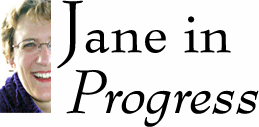 |
|
 |
 |
Looking for tips and tricks to the art of writing for television? Welcome to the blog of experienced television writer Jane Espenson. Check it out regularly to learn about spec scripts, writing dos and don'ts, and what Jane had for lunch! (RSS:  ) |
|
|
Home » Archives » August 2007 » Photo Play
[Previous entry: "Hot Rat-Taunting Story Documents"] [Next entry: "I've Said it Before..."]
08/29/2007: Photo Play
Gentle Reader and friend-of-friend-of-the-blog Chris in Los Angeles writes in with a wonderful technical question. She (or he) says:
How would you format a montage of still photos with voiceover? Should I write in the location of each picture on the Scene Heading Line? Or can I put some kind of overall "Montage" note and then describe what's in each picture, one by one? If that's the case, what should I put on the scene heading line?
First off, let me just say that this is the kind of stuff that drives newer writers nuts, because they're worried about doing it wrong, about breaking a rule. The fact is, however, that when you're faced with an unusual situation, the best way to do it is just to be as clear as possible for the reader and not worry too much about rules. This means, of course, that different writers would tackle this situation in different ways, and none of them would be correct or incorrect.
Now, I assume you're not talking about panning across a mantelpiece and showing us the photos there, because then I don't think you'd be asking about the scene heading and using the word 'montage'. But anyway, just for completeness, if it was the mantelpiece thing, it would probably go like this (please forgive any indentation oddness):
INT. LIVING ROOM
We PAN ACROSS a series of photos on the mantelpiece: A WEDDING PHOTO from the 1960s...
WOMAN (V.O.)
It used to seem like it was going to be easy.
...A POSED SHOT of the same couple, now with two young children...
WOMAN (V.O.)
Get married, start a family. Everyone did it.
But you're not asking about that. You're asking about a genuine montage, right, Chris? A location-less series of still shots, like in a Ken Burns documentary? That's more unusual, and I can imagine it being done in a couple different ways. Here is one way that I might use:
A STILL PHOTO
Fills the frame. Black and White. A BOY AND HIS DOG, outside what looks like a Midwestern farm house.
MAN (V.O.)
This is what I remember.
ANOTHER PHOTO, color now. A YOUNG MAN IN CAP AND GOWN.
MAN (V.O.)
A normal life. At least that's what it seemed like at the time.
The photos start passing faster now... THE MAN in a DORM ROOM, in a WEDDING PHOTO, holding a BABY, posed in front of a HOUSE. They FLIP past us faster and faster, until they BLUR. Over these:
MAN (V.O.)
I assumed, as everyone else did, that I was only going to be given this one lifetime...
And on from there. But it's totally flexible. That one action line where I list a lot of photos in a row? You could break those each out into its own shot line if you wanted to. It's all about whatever you think best conveys what you're picturing. Play around with it.
Notice that whether you use the "scene heading" or "shot" or even "action" designation for the bits of prose is entirely up to you. The reader won't be able to tell which they are, anyway.
All the standard rules of script formatting assume you're going to be doing the standard script thing, having action and dialogue set within a series of locations. When you deviate from that formula, you can deviate from the formatting rules -- you can start a scene without either an "Int" or an "Ext". You can blur the distinction between scenes and shots and description. The categories are supposed to help you. When they stop helping you, find another way. As always, the key is to make your choices clear and confident.
Lunch: that heirloom tomato salad again. Lovely.
|
|
|
 |
|
Get Blog Updates Via Email
|
|
 |

